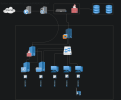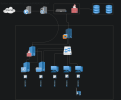There is a certain amount of irony here as that I am an IT guy not knowing which way I need to go, as I had other jobs in life and mostly in the stupid windows world, the current result of my proxmox setup is definately too overwhelming and thus issues WILL come, and with far not hassle free and secure 
So, the current whole scenario:
So, given all the ways one could go, and given the best practices, one could out of experience, could give me the mixture of tools/solutions/practices/simple ideas/ for my target setup, that I could then research and/or implement on my own and have a rocksolid environment in the end, so we could focuse on the startup matters after that. Today the NextCloud broke prior some file exchange with its occasional "Bad Gateway 502/504/506" and this got me boling... When the startup grows, I will simply load the whole config to a newer machine through failover clustering and scale it up. Let’s hope!
even it is kind of a struggle now, I am very thankful that I am having such a task, cause it is putting me back on track in the real IT world + I am more annoyed than unable to do the use case setup, but should I try every single tool/program/practise only to find a well known scenario in the end as well?
Thanks to you all, which are willing to help!
So, the current whole scenario:
- Server - DL380, SSDs in raid
- QNAP storage - 2 arrays, 1 in stripping, 1 in mirroring (thus the total space gets maximazed, given the different sizes of all 4 hdds) (confiugered to some extent, no backup solution implemented, proxmox sees the arrays)
- Old SME router box (which I could dump for some SME second hand grade thing, no teaming, and 100Mbps ethernet, has portforwarding)
- 2 vWorkstations for 3d Modelling with passedthrough physical GPUs and smth like PARsec for interaction with them (done)
- 2 more simple office LInux vPCs (done, not needed currently)
- Openproject (done, also integrated with nextcloud)
- NEXTCLOUD - (done, both should be better interconnected. It is killing me with the aforementioned issues - intermitent bad gateways, intermitent build in editing not working)
- Domain name. (bought)
- Cloudflare (I am not happy about it, as it is an additional network layer + imposes bans on bigger files + you never know if it is the RC of an issue and speedwise one could believe it is choked, so it could make money for their paid plans)
- Nginx proxy manager with encryption between the CFlare and the Ngnix (it is very buggy IMO)
- a lowcost startup infrastructure for upto 5 participants(eventually more as NEXTCLOUD users only ) all over Europe, giving them the ability to follow up on the project, work online with documents, exchange files, and work in the vPCs and vWorkstations environments (3d Modelling)
- reliable and secure environment, which won’t need DIY miracles every now and then, out of the regular maintainance once an year or every second year.
- a reliable and free backuping solution to keep the images of the configured setup + to run a hassle free backuping of user data - Nextcloud, Openproject, vWindows, vLinux.
So, given all the ways one could go, and given the best practices, one could out of experience, could give me the mixture of tools/solutions/practices/simple ideas/ for my target setup, that I could then research and/or implement on my own and have a rocksolid environment in the end, so we could focuse on the startup matters after that. Today the NextCloud broke prior some file exchange with its occasional "Bad Gateway 502/504/506" and this got me boling... When the startup grows, I will simply load the whole config to a newer machine through failover clustering and scale it up. Let’s hope!
even it is kind of a struggle now, I am very thankful that I am having such a task, cause it is putting me back on track in the real IT world + I am more annoyed than unable to do the use case setup, but should I try every single tool/program/practise only to find a well known scenario in the end as well?
Thanks to you all, which are willing to help!
Last edited:



